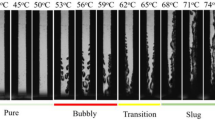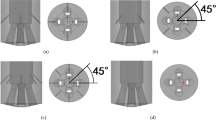Abstract
A reasonable discrimination method for ablative control mechanism in solid-propellant rocket nozzle can improve the calculation accuracy of ablation rate. Based on the different rate constants for reactions of C with H2O and CO2, a new discrimination method for ablative control mechanism, which comprehensively considers the influence of nozzle surface temperature and gas component concentration, is presented. Using this new discrimination method, calculations were performed to simulate the nozzle throat insert ablation. The numerical results showed that the calculated ablation rate, which was more close to the measured values, was less than the value calculated by diffusion control mechanisms or by double control mechanisms. And H2O was proved to be the most detrimental oxidizing species in nozzle ablation.
Similar content being viewed by others
References
Huang H M, Du S Y, Wu L Z. Analysis of the ablation of C/C composites. Acta Mater Comp Sinica, 2001, 18: 76–80
Yin J, Xiong X, Zhang H B. Research and development of C/C composites used for SRM. Mater Rev, 2004, 18: 46–48
Fang D Y, Xia Z X, Jiang C L. Engineering calculation of C/C throat insert ablation. J Solid Rocket Tech, 2000, 23: 24–27
He H Q, Zhou X. Ablative control mechanism in solid rocket nozzle. J Propul Tech, 1993, 4: 36–41
Kuo K K, Keswani S T. A comprehensive theoretical model for carbon-carbon composite nozzle recession. Combus Sci Tech, 1986, 42: 177–192
Acharya R, Kuo K K. Effect of chamber pressure and propellant composition on erosion rate of graphite rocket nozzle. J Propul Power, 2007, 23: 1242–1254
Huang H M, Xu X L, Jiang G Q. Discrimination for ablative control mechanism in solid-propellant rocket nozzle. Sci China Ser E-Tech Sci, 2009, 52: 1558–1563
Borie V, Brulard J, Lengelle G. Aerothermochemical analysis of carbon-carbon nozzle regression in solid-propellant rocket motors. J Propul Power, 1989, 56: 65–73
Klager K. The interaction of the efflux of solid propellants with nozzle materials. Propell Explos, 1977, 2: 55–63
Libby P A, Blank T R. Buring carbon particles in the presence of water vapor. Combus Flame, 1981, 141: 123–147
Bradley D, Dixon-Lewis G, Habik E S, et al. The oxidation of graphite powder in flame reacion zones. In: 20th Souposium (International) on Combustion. Piusburgh, PA, 1984. 931–940
Piyush T, Vigor Y. Chemical erosion of carbon-carbon/graphite nozzles in solid-propellant rocket motors. J Propul Power, 2008, 24: 822–833
Daniele B, Francesco N, Emanuele M. Coupled analysis of flow and surface ablation in carbon-carbon rocket nozzles. J Space Rocket, 2009, 46: 492–500
Piyush T, Vigor Y. Mitigation of graphite nozzle erosion by boundary-layer control in solid rocket motors. J Propul Power, 2009, 25: 1079–1085
Cai T M. Numerical Simulations of Working Progress of Solid Rocket Engine. Xi’an: Northwestern Polytechnical University Press, 1990
Geisler R L. The relationship between solid propellant formulation variables and nozzle recession rates. JANNAF Rocket Nozzle Technology Subcommittee Meeting. Lancaster, CA, 1978
Author information
Authors and Affiliations
Corresponding author
Rights and permissions
About this article
Cite this article
Zhang, B., Liu, Y., Wang, C. et al. New discrimination method for ablative control mechanism in solid-propellant rocket nozzle. Sci. China Technol. Sci. 53, 2718–2724 (2010). https://doi.org/10.1007/s11431-010-4081-6
Received:
Accepted:
Published:
Issue Date:
DOI: https://doi.org/10.1007/s11431-010-4081-6




